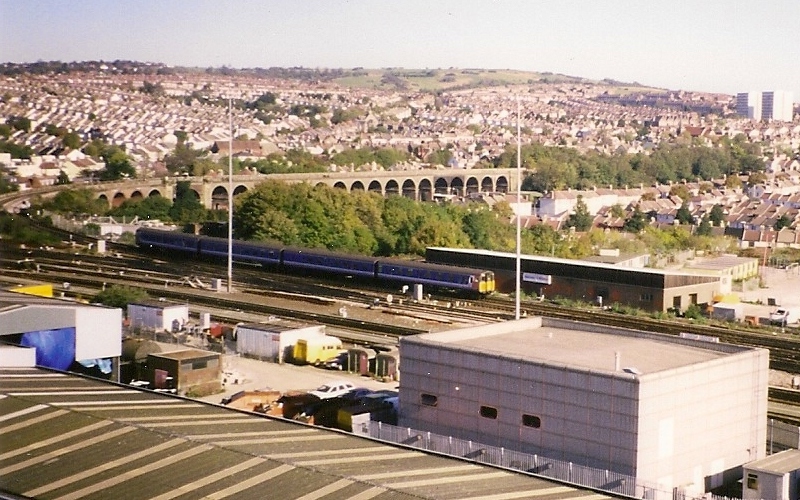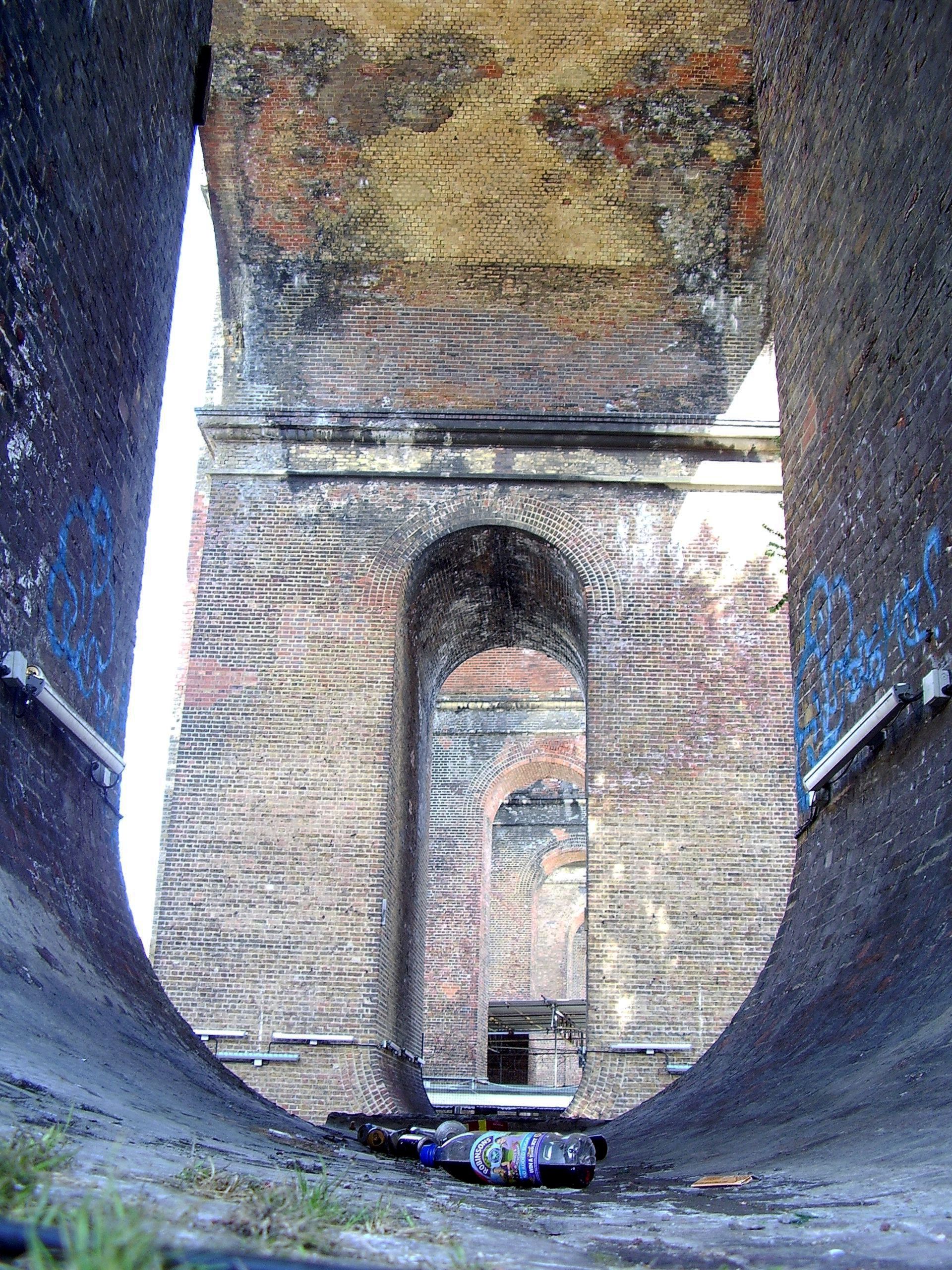London Road viaduct on:
[Wikipedia]
[Google]
[Amazon]
The London Road Viaduct is a brick railway viaduct in Brighton, part of the city of
 Brighton's most significant bombing raid of the
Brighton's most significant bombing raid of the


 The structure is long, and reaches a maximum height of above the floor of the valley. It consists of 26 semi-circular arches each of with piers of thick at the base and thick at the top, together with one elliptical arch of over a section of the A23 London Road called Preston Road. The piers of this arch are thick at the base and thick at the top. Each pier contains a jack arch with a semi-circular
The structure is long, and reaches a maximum height of above the floor of the valley. It consists of 26 semi-circular arches each of with piers of thick at the base and thick at the top, together with one elliptical arch of over a section of the A23 London Road called Preston Road. The piers of this arch are thick at the base and thick at the top. Each pier contains a jack arch with a semi-circular
Brighton and Hove
Brighton and Hove () is a city and unitary authority in East Sussex, England. It consists primarily of the settlements of Brighton and Hove, alongside neighbouring villages.
Often referred to synonymously as Brighton, the City of Brighton and H ...
in East Sussex, England. It carries the East Coastway Line between Brighton and London Road railway stations. Built in the 1840s for the Brighton, Lewes and Hastings Railway by the locomotive engineer and railway architect John Urpeth Rastrick
John Urpeth Rastrick (26 January 1780 – 1 November 1856) was one of the first English steam locomotive builders. In partnership with James Foster, he formed Foster, Rastrick and Company, the locomotive construction company that built the '' ...
, the sharply curving structure has 27 arches and about 10 million bricks. It is still in constant use, and is listed
Listed may refer to:
* Listed, Bornholm, a fishing village on the Danish island of Bornholm
* Listed (MMM program), a television show on MuchMoreMusic
* Endangered species in biology
* Listed building, in architecture, designation of a historicall ...
at Grade II* for its historical and architectural significance.
History
The London and Brighton Railway Act, passed on 15 July 1837, granted the London & Brighton Railway Company the right to build a railway line from Norwood to Brighton, abranch line
A branch line is a phrase used in railway terminology to denote a secondary railway line which branches off a more important through route, usually a main line. A very short branch line may be called a spur line.
Industrial spur
An industr ...
from Brighton to Shoreham-by-Sea
Shoreham-by-Sea (often shortened to Shoreham) is a coastal town and port in West Sussex, England.
The town is bordered to its north by the South Downs, to its west by the Adur Valley and to its south by the River Adur and Shoreham Beach on th ...
and another from Brighton to Newhaven via Lewes. The line to Shoreham-by-Sea was completed first, in 1840, and the Brighton Main Line
The Brighton Main Line (also known as the South Central Main Line) is a major railway line in the United Kingdom that links Brighton, on the south coast of England, with central London. In London the line has two branches, out of and station ...
opened in its entirety in September 1841; but the route eastwards from Brighton towards Lewes was delayed until 8 June 1846. A new company, the Brighton, Lewes & Hastings Railway Company, was formed to build this line; John Urpeth Rastrick was employed as the surveyor and architect. The two companies and others amalgamated in July 1846 to form the London, Brighton and South Coast Railway
The London, Brighton and South Coast Railway (LB&SCR; known also as the Brighton line, the Brighton Railway or the Brighton) was a railway company in the United Kingdom from 1846 to 1922. Its territory formed a rough triangle, with London at its ...
.
In the 1840s, the land northeast of Brighton station was undeveloped, consisting of fields. It lay in a steep-sided valley running from north to south, created by the River Wellesbourne (by then, reduced to an intermittently flowing, mostly underground winterbourne). Rastrick had to decide whether to cross this with an embankment or a viaduct. Local opinion favoured an embankment, and he faced opposition and criticism when he chose to build a viaduct. Nevertheless, he planned a route for it, and laid the foundation stone
The cornerstone (or foundation stone or setting stone) is the first stone set in the construction of a masonry foundation. All other stones will be set in reference to this stone, thus determining the position of the entire structure.
Over tim ...
on 29 May 1845. Construction took 10 months: the structure was ready on 28 March 1846, more than two months before the line to Lewes opened. By the 1870s, dense terraced housing
In architecture and city planning, a terrace or terraced house ( UK) or townhouse ( US) is a form of medium-density housing that originated in Europe in the 16th century, whereby a row of attached dwellings share side walls. In the United State ...
surrounded the viaduct: residential development was stimulated by the opening of the railway.
Second World War
World War II or the Second World War, often abbreviated as WWII or WW2, was a world war that lasted from 1939 to 1945. It involved the vast majority of the world's countries—including all of the great powers—forming two opposi ...
severely damaged London Road Viaduct. At 12.30pm on 25 May 1943, Focke-Wulf fighter-bomber aircraft dropped several bombs on Brighton, five of which landed on the railway. One demolished two arches and one pier at the west end of the viaduct, two arches west of the Preston Road span, leaving the tracks spanning the gap in mid-air. Despite this, a temporary repair allowed trains to start using the viaduct again within 24 hours; in less than a month, the service was back to normal. Until the arches were fully repaired in September 1943, however, a speed restriction was enforced and Preston Road could be seen through the gaps between the sleepers
''Sleepers'' is a 1996 American legal crime drama film written, produced, and directed by Barry Levinson, and based on Lorenzo Carcaterra's 1995 book of the same name. The film stars Kevin Bacon, Jason Patric, Brad Pitt, Robert De Niro, Dustin H ...
where the brickwork had been blasted away. The replacement brickwork, darker than that of the main structure, can be seen from the road below.
Architecture


 The structure is long, and reaches a maximum height of above the floor of the valley. It consists of 26 semi-circular arches each of with piers of thick at the base and thick at the top, together with one elliptical arch of over a section of the A23 London Road called Preston Road. The piers of this arch are thick at the base and thick at the top. Each pier contains a jack arch with a semi-circular
The structure is long, and reaches a maximum height of above the floor of the valley. It consists of 26 semi-circular arches each of with piers of thick at the base and thick at the top, together with one elliptical arch of over a section of the A23 London Road called Preston Road. The piers of this arch are thick at the base and thick at the top. Each pier contains a jack arch with a semi-circular soffitt
A soffit is an exterior or interior architectural feature, generally the horizontal, aloft underside of any construction element. Its archetypal form, sometimes incorporating or implying the projection of beams, is the underside of eaves (to ...
and invert to reduce the number of bricks required. The piers are thicker on the outside than on the inside because the viaduct is constructed on a sharp curve: trains reach the viaduct almost immediately after leaving the Brighton Main Line, and the line continues to curve away for several hundred metres. Of the 27 arches, 16 have a radius of curvature
In differential geometry, the radius of curvature, , is the reciprocal of the curvature. For a curve, it equals the radius of the circular arc which best approximates the curve at that point. For surfaces, the radius of curvature is the radius o ...
of , and 11 have a radius of .
Approximately 10 million bricks were needed to build the viaduct. The brickwork is red and brown, with yellow brick dressings. The wartime reconstruction used blue brick
Staffordshire blue brick is a strong type of construction brick, originally made in Staffordshire, England.
The brick is made from the local red clay, Etruria marl, which when fired at a high temperature in a low-oxygen reducing atmosphere ta ...
, a darker type often used for heavy-duty construction. The 26 narrower arches are round-headed, whereas the wider span across Preston Road is elliptical. Each pier has a long, rectangular opening on each inner side, with rounded arches at the top and bottom. Running along the top of the viaduct on both sides is a balustrade with stone balusters.
The viaduct today
London Road Viaduct was listed at Grade II* byEnglish Heritage
English Heritage (officially the English Heritage Trust) is a charity that manages over 400 historic monuments, buildings and places. These include prehistoric sites, medieval castles, Roman forts and country houses.
The charity states that i ...
on 19 April 1974. This status is given to "particularly important buildings of more than special interest". As of February 2001, it was one of 70 Grade II*-listed buildings and structures, and 1,218 listed buildings of all grades, in the city of Brighton and Hove
Brighton and Hove () is a city and unitary authority in East Sussex, England. It consists primarily of the settlements of Brighton and Hove, alongside neighbouring villages.
Often referred to synonymously as Brighton, the City of Brighton and H ...
.
As of 2009, 174 scheduled passenger trains
In rail transport, a train (from Old French , from Latin , "to pull, to draw") is a series of connected vehicles that run along a railway track and transport people or freight. Trains are typically pulled or pushed by locomotives (often know ...
(87 eastbound and 87 westbound), all operated by Southern, cross the viaduct each weekday. There are fewer train movements at weekends.
References
{{Brighton and Hove Railway viaducts in East Sussex Grade II* listed buildings in Brighton and Hove Grade II* listed railway bridges and viaducts